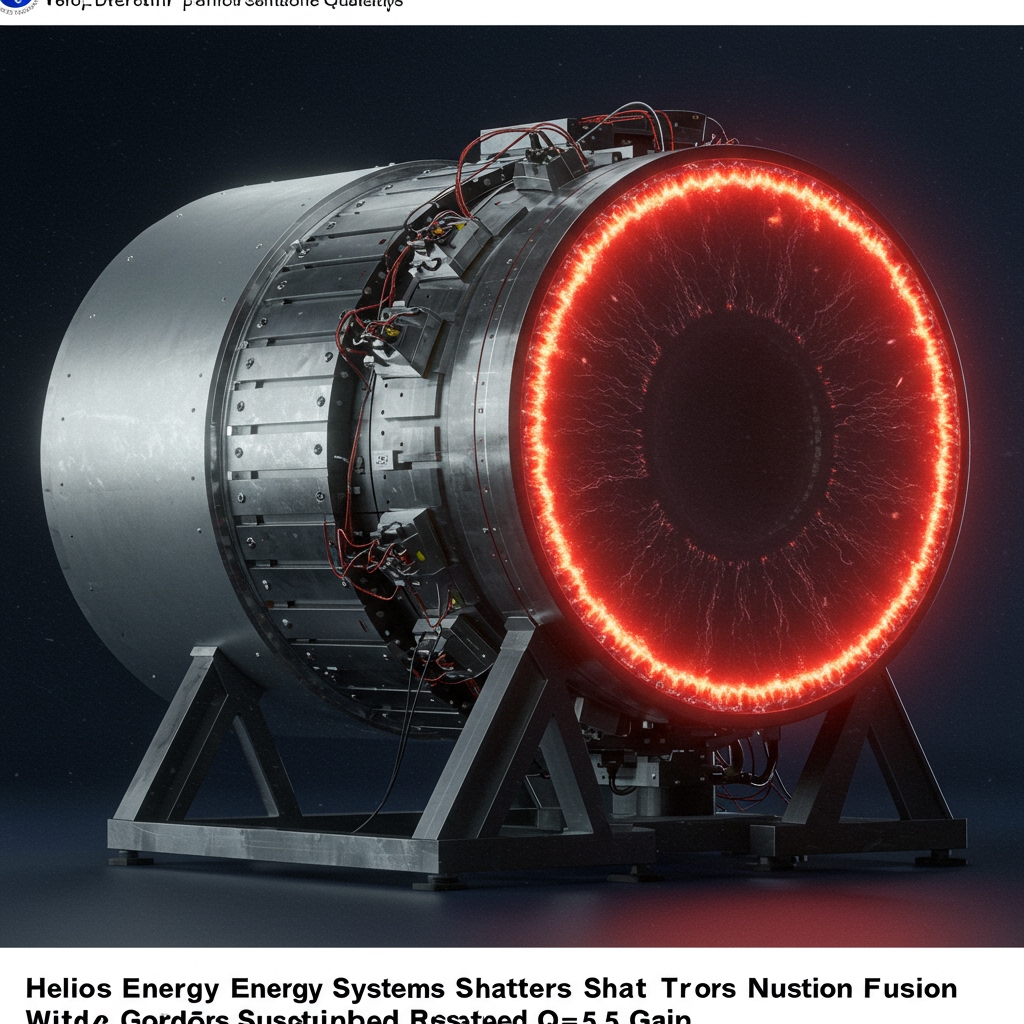Fusion Energy Takes Monumental Leap with Helios Energy Systems’ Breakthrough
Las Vegas, NV – In a landmark announcement that reverberated through the global scientific and energy communities, private research firm Helios Energy Systems reported on January 10, 2025, that it had achieved a sustained net energy gain from its experimental fusion reactor located in Nevada. The company stated its device successfully maintained a net energy gain, quantified by the ‘Q’ factor, of 5.5 for a duration exceeding ten minutes. This achievement represents a dramatic and unprecedented step forward in the long quest for clean, virtually limitless fusion power.
Net energy gain, often expressed as the Q factor, is a critical metric in fusion research. It compares the energy output from the fusion reaction to the energy input required to initiate and sustain the reaction. A Q value greater than 1 signifies net energy gain, meaning the fusion process itself produced more energy than was delivered directly to the plasma to power the reaction. Helios Energy Systems’ reported Q of 5.5 indicates their system produced 5.5 times the energy input during the sustained ten-minute period.
This achievement significantly surpasses previous milestones in fusion research. Notably, it dramatically overshadows the achievement by the National Ignition Facility (NIF), a U.S. government research facility, which reported a brief net energy gain of approximately 1.5 in 2022. While NIF’s accomplishment was a crucial demonstration of the fundamental physics required for fusion ignition, the Helios Energy Systems breakthrough goes much further by achieving a significantly higher gain and, critically, sustaining it for an extended period.
A Decade in the Making: The Helios Approach
Helios Energy Systems, a privately funded venture, has been pursuing a novel approach to magnetic confinement fusion. While specific technical details of their reactor design and operational parameters remain proprietary, the company indicated that their success stems from advancements in plasma confinement stability, heating efficiency, and novel superconducting magnet technology. The ability to sustain the Q=5.5 gain for over ten minutes demonstrates a level of control and stability over the fusion plasma that has long been a significant hurdle in the field.
The breakthrough was spearheaded by chief scientist Dr. Evelyn Reed and her dedicated team of physicists and engineers. Speaking at the announcement event, Dr. Reed emphasized the culmination of years of relentless effort and innovative problem-solving. “This isn’t just a scientific curiosity,” Dr. Reed stated. “This is a clear demonstration that sustained, high-gain fusion is within our technological reach. It moves fusion decisively from the realm of theoretical possibility into a concrete engineering challenge with a clear path forward.”
Expert Reactions and Global Implications
News of the Helios Energy Systems breakthrough was met with widespread excitement among experts in the fusion community. Dr. Ian Bremmer, a leading physicist not affiliated with Helios, called the announcement a “game-changer.” “Achieving a sustained Q of 5.5 is not just an incremental step; it’s a leap,” Dr. Bremmer commented. “It dramatically improves the prospects for building commercially viable fusion power plants. The engineering challenges are still significant, but this takes a huge question mark off the table regarding the core physics and energy balance.”
The potential implications of commercially viable fusion power are immense. Fusion promises a clean, abundant, and reliable energy source that produces no greenhouse gases and relatively low volumes of short-lived radioactive waste compared to conventional nuclear fission. Success in fusion could fundamentally reshape global energy strategies, providing energy security and helping to combat climate change on an unprecedented scale.
Accelerating the Timeline: From Lab to Grid
This achievement is expected to significantly accelerate the timeline for bringing fusion energy to the grid. While previous estimates for commercial fusion power often stretched decades into the future, the sustained high gain demonstrated by Helios suggests that the necessary engineering and economic challenges could be overcome much sooner. Many experts now speculate that the first grid-connected fusion plants could be operational within the next decade.
The Helios Energy Systems breakthrough is also anticipated to spur a massive increase in investment in the fusion sector. Private investors, recognizing the potential for a disruptive technology valued in the trillions, are likely to pour more capital into fusion research and development firms. Governments, too, may increase funding for both public research programs and partnerships with private industry, seeing fusion as a strategic imperative for future energy security and environmental goals.
Furthermore, the success is expected to foster increased international collaboration. Sharing knowledge and resources will be crucial to accelerating the development and deployment of fusion technology globally. While competition among firms and nations exists, the sheer scale of the challenge and the global benefits of success incentivize cooperation on foundational scientific and engineering problems.
The Path Ahead: Challenges Remain
Despite the monumental nature of this achievement, the path to commercial fusion power is not without its challenges. Scaling the technology to power plant size, developing advanced materials capable of withstanding the extreme conditions within a fusion reactor, creating efficient and cost-effective fuel cycles, and integrating fusion plants into existing energy grids are all significant hurdles that still need to be overcome.
However, the sustained Q=5.5 gain demonstrated by Helios Energy Systems provides compelling evidence that the fundamental physics required for energy-producing fusion is now well understood and controllable at a level far exceeding previous demonstrations. It transforms the primary challenge from proving scientific feasibility to solving complex engineering problems.
In conclusion, the announcement from Helios Energy Systems on January 10, 2025, marks a pivotal moment in energy history. By achieving a sustained net energy gain of 5.5 for over ten minutes, they have dramatically advanced the state of the art in fusion research, offering a powerful glimpse into a future powered by clean, abundant energy. Led by Dr. Evelyn Reed and her team, this breakthrough is poised to accelerate investment, collaboration, and technological development, potentially reshaping the global energy landscape within the next ten years.





